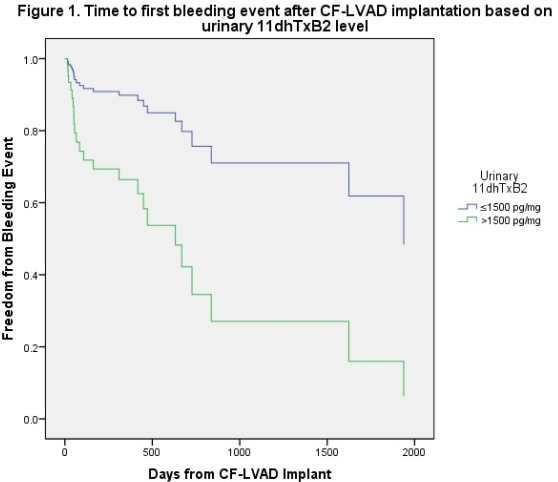Elevated Urinary 11-Dehydrothromboxane B2 Is Associated with Increased Bleeding Risk in Left Ventricular Assist Device Patients.
1Division of Cardiology, Emory University School of Medicine, Atlanta, GA
2Division of Cardiothoracic Surgery, Emory University School of Medicine, Atlanta, GA
3Heart Transplant Services, Emory University Hospital, Atlanta, GA
4Department of Medicine, Emory University School of Medicine, Atlanta, GA
5Department of Pathology, Emory University School of Medicine, Atlanta, GA.
Meeting: 2016 American Transplant Congress
Abstract number: 247
Keywords: Anticoagulation, Heart assist devices
Session Information
Session Name: Concurrent Session: Molecular and Bio-Markers in Hearts and VADs - A New Hope
Session Type: Concurrent Session
Date: Monday, June 13, 2016
Session Time: 2:30pm-4:00pm
 Presentation Time: 3:42pm-3:54pm
Presentation Time: 3:42pm-3:54pm
Location: Room 102
Purpose: To understand if there is a relationship between aspirin resistance as measured by elevated levels of urinary 11-dehydrothromboxane B2 in patients supported with continuous flow-left ventricular assist devices
Methods: 66 patients with cf-LVAD (mean age 50±11 years, 68% male, 65% African American) and currently being followed at an academic medical center had urinary 11-dehydrothromboxane B2 (11dhTxB2) levels tested at time of enrollment to ascertain aspirin resistance. These values were dichotomized using 1500 pg/mg as the cutoff based on criteria used to define aspirin resistance. Chi-square test was used to determine significance with regards to incidence of clotting and bleeding. Cox regression model was performed to evaluate the association between elevated 11dhTxB2 and events after adjustment for age, gender, race, and supratherapeutic INR (>3.0)
Results: 25 patients (37.9%) had at least one bleeding event during the follow-up period. Of the 32 patients (48.5%) with an elevated 11dhTxB2, 19 patients (59.4%) experienced a bleeding event (p<0.001). After adjustment for the aforementioned covariates, elevated 11dhTxB2 was an independent predictor of bleeding (hazard ratio 3.18, 95% confidence interval 1.25 to 11.62, p=0.018) with increased risk noted from time of implant (Figure 1). No other covariates in the model were significant predictors of bleeding.
Conclusion: Elevated 11dhTxB2 is an independent predictor of bleeding events after LVAD implantation. Measurement of 11dhTxB2 may improve risk stratification and anticoagulation management in LVAD patients. Further study is required to better characterize the relationship in this patient population.

CITATION INFORMATION: Schultz W, Pekarek A, Cole R, Duncan A, Laskar S, Smith A, Nguyen D, Vega J, Gupta D. Elevated Urinary 11-Dehydrothromboxane B2 Is Associated with Increased Bleeding Risk in Left Ventricular Assist Device Patients. Am J Transplant. 2016;16 (suppl 3).
To cite this abstract in AMA style:
Schultz W, Pekarek A, Cole R, Duncan A, Laskar S, Smith A, Nguyen D, Vega J, Gupta D. Elevated Urinary 11-Dehydrothromboxane B2 Is Associated with Increased Bleeding Risk in Left Ventricular Assist Device Patients. [abstract]. Am J Transplant. 2016; 16 (suppl 3). https://atcmeetingabstracts.com/abstract/elevated-urinary-11-dehydrothromboxane-b2-is-associated-with-increased-bleeding-risk-in-left-ventricular-assist-device-patients/. Accessed December 18, 2025.« Back to 2016 American Transplant Congress
